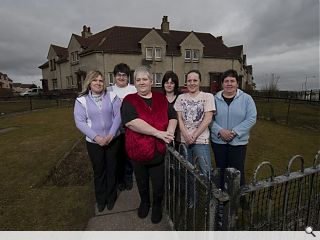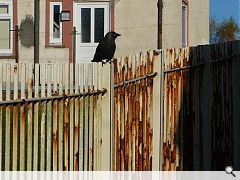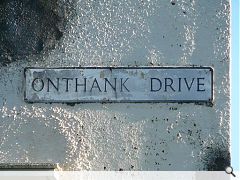Real Estates
7 Dec 2010
Onthank? No thanks
BBC fly on the wall documentary, The Scheme, provided an unexpected ratings success this Spring, until that is the series was prematurely taken off air when one of its “stars” ended up in court facing charges of assault and intent to rob.
In its brief run however the show lifted a lid on the tawdry lives of some of the less salubrious denizens of one of Scotland’s most deprived housing estates. It brought into stark relief life in the darker recesses of society and graphically depicts intravenous drug taking, assaults and even captures one resident providing a false alibi to police.
Foremost in TV viewer’s affections were Marvin Baird and his inseparable canine sidekick, Bullet. The heroin addict has become a familiar sight on the streets of Kilmarnock after coming up with a money making wheeze – flogging autographed cigs.
The Kilmarnock Standard reported that Baird had been sighted in Kilmarnock’s Burns Mall flogging individual cigs autographed by the charismatic chancer at £1 a pop. It’s a brand which has also branched out into a range of t-shirts sporting a range of favourite Marvinisms including: “Happy as Larry… could not be happier” and the immortal line: “Oh man someone’s kicked doon ma fence.”
This new found celebrity has come at a price as far as Marvin is concerned however, he rues the day he ever set foot in front of the BBC’s cameras: “They wanted a circus and we were the clowns,” he laments.
A spokesperson for East Ayrshire Council, who are now left with the thankless task of raising the battered image of Kilmarnock, advised Urban Realm that the show was “not representative” of the area and the shows producers had singled out a pocket of the worst area for broadcast. In an effort to give a fairer depiction of the area Urban Realm contacted Keppie Design’s David Ross, who hails from the estate, to provide the inside story on living in Scotland’s most notorious neighbourhood.
In Search of Community Identity
The link between environment and behaviour is well established but it was brought into more personal focus for me when BBC Scotland screened their television programme ‘The Scheme’ earlier this year. The fly-on-the-wall style documentary set in Onthank, the residential area in Kilmarnock where I grew up and where my mother still lives, predictably homed in on the more extreme aspects of daily life for a small group of Onthank’s residents. It painted a picture which was criticised by some for its exploitation of its subjects and by others for its misrepresentation of the realities of modern social problems. On the other side of the debate, some chose to suggest that the far reaching impact of the programme might lead to positive changes in child protection legislation. Inevitably we draw our own conclusions, our perception of these places and by association of the people in those places, based on our media-informed impressions. Often they are misguided or just plain wrong.
I watched the first episode of the programme but there was something oddly unfamiliar about it. The streets and cul-de-sacs featured seemed far more pallid, grey and washed-out than I recalled them from my own childhood. The title of the programme in itself was disorientating as to my own recollection, Onthank has never been referred to by that name. The repetition of roughcasted, semi detached houses with small front gardens fenced off from a tarmac frontage is a characteristic of numerous unremarkable social housing estates all across Scotland but I hadn’t previously considered just how little relief from this there was. Maybe my perception has changed. It’s clear that the very places that would benefit most from a policy of better and more distinctive ‘placemaking’ are those typically represented by Onthank as opposed to slightly more distinct and already advantaged areas. After all, if it looks and feels like everywhere else, it might be difficult to suggest how a sense of place with its own cultural identity might emerge.
One of the most enriching projects I have been involved in was for a Community Outreach Building in North West Belfast around ten years ago. When this project was originally conceived, the site chosen for it in Springvale was an intimidating open area between the Catholic and Protestant estates either side of Springfield Road. As our design was being developed we faced much of the same initial negativity faced by many involved with new buildings in difficult locations: "they'll wreck it", "it'll be ruined", ‘it won’t stay white for long’, "waste of money" etc.
But with the benefit of looking back over a decade of significant change for Belfast this hasn’t happened. Both sides of the community have embraced this brave little building and its training programmes are now regularly oversubscribed. I believe it wouldn’t have been as successful in its mission had its design been mediocre. It has become the focal point of a community which had all the typical social issues and a few unique ones as well. It opens early and stays open until late giving its diverse community of young and old somewhere to go and offering something positive for them to do. Its success has also assisted in the promotion of a new building adjacent for Belfast Metropolitan College who firmly believe that education is the way to offer hope and inspiration, and to foster community pride.
For any community to grow and develop positively, identity is important and a sense of ownership is crucial in creating places and environments which offer hope. It might be anticipated for an architect to advocate that these aspirations are best addressed by building new structures but a greater sense of community identity might be achieved in estates like Onthank by actually removing some of the buildings and replacing them with safe, distinctive public spaces featuring public art that the community may have had an involvement in developing.
Public art can evoke a sense of pride which far outweighs the financial outlay. It can elevate the everyday experience and enhance the environment, create thought provoking landmarks and celebrate identity. And where is that required more than in the so called "deprived" areas of our towns and cities? It might not win any Turner Prizes, but on the streets of estates like Onthank visual art and culture should have the widest scope possible. It can offer the greatest opportunity for interpretation and the "humanizing" of those spaces. It could be further argued that in times of economic austerity and hopelessness people most need their spirit culturally, emotionally and philosophically lifted.
Andy Scott is a celebrated Public Artist whose work has become a landmark of many parts of Scotland with allegedly "bad reputations" where it would apparently be money wasted. Well, apparently not. Local response to his work in areas such as Springburn, Blochairn, Faifley and Peterhead, as well as more recent landmarks in larger places like Cumbernauld reinforces the strong sense of community that distinctive and well designed places promote.
‘I've even had situations where the local residents groups themselves sought out the funding necessary to commission me as their preferred artist for their sculpture, and given me eloquent and studied briefs more concise than those given by many arts consultancies and Councils. Five and six figure sums, mind you, in areas with high unemployment and myriad social problems... "Why should the art only be in the posh areas? Are we not good enough son?"
As Andy would testify, the problems facing estates such as Onthank are not going to be solved by simply knocking down the odd four-in-a-block and replacing it with a sculpture set in an open space. The issues are far more complicated. Perhaps the answer lies in education in its widest sense whereby individuals might be assisted in developing a new, more hopeful ambition for their lives and the environments to which they contribute. Investment is inevitably required and there is little point in believing that successful long term regeneration can be achieved by ‘smoke and mirrors’. The ‘regeneration’ of Council-built schemes all over Scotland has rarely resulted in anything more than an ordinariness of design. The people from places like Onthank deserve a different approach.
Working with the community in North Belfast reinforced my view that, above all people make places, not the other way around. But the people have to be given a forum before positive momentum builds and the imperative to make place improvements happen. One building will not achieve a perceptive shift in a community’s fortunes all by itself but projects like Onthank’s excellent new North West Kilmarnock Area Centre, married to an imaginative and inclusive plan for the promotion of a hierarchy of unique public spaces will help build the level of civic pride which is a catalyst for a culture of aspiration.
David F Ross
Design Director
Keppie Design
September 2010
|
|





